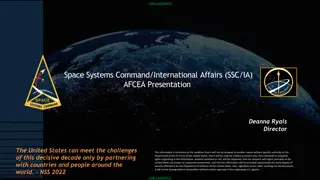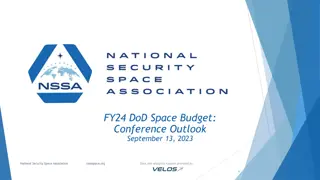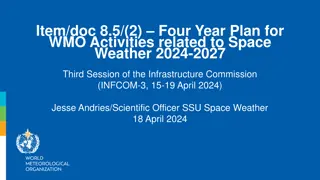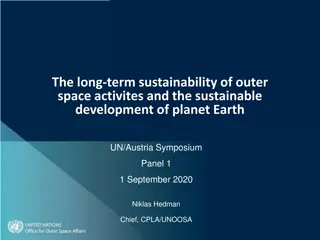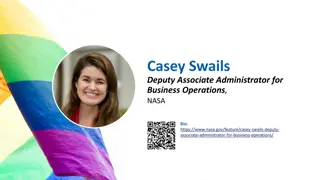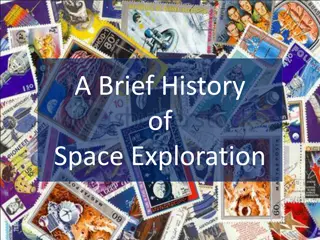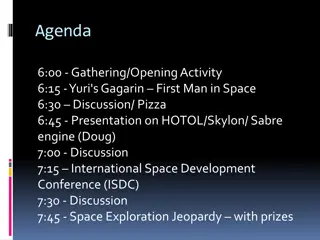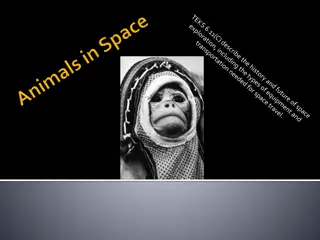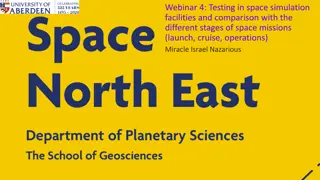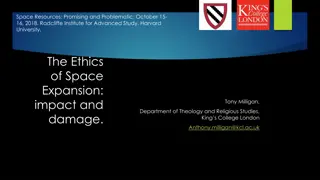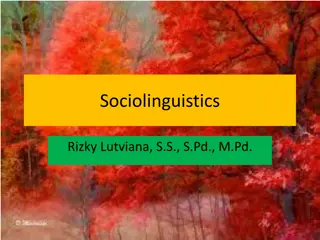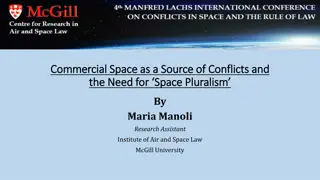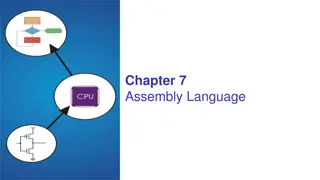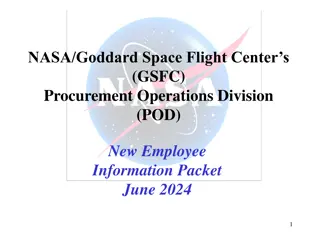The Language of Space & Time
Delve into the intricate world of conceptual metaphors, exploring how they structure sets of conceptual domains and facilitate reasoning across different domains. Uncover the metaphorical mappings that define complex concepts like love, journeys, and causal events. See examples of how metaphors enhance our understanding and communication, shaping our perceptions of time and relationships. Discover the metaphorical basis for our conceptualization of time and how it influences our view of events and experiences.
Download Presentation

Please find below an Image/Link to download the presentation.
The content on the website is provided AS IS for your information and personal use only. It may not be sold, licensed, or shared on other websites without obtaining consent from the author.If you encounter any issues during the download, it is possible that the publisher has removed the file from their server.
You are allowed to download the files provided on this website for personal or commercial use, subject to the condition that they are used lawfully. All files are the property of their respective owners.
The content on the website is provided AS IS for your information and personal use only. It may not be sold, licensed, or shared on other websites without obtaining consent from the author.
E N D
Presentation Transcript
The Language of Space & Time Svetlana Nedelcheva 1
Conceptual Metaphor Theory Overview Sets of mappings structure sets of 2 conceptual domains (large-scale coherent bodies of knowledge), providing a conceptual metaphor The structuring is asymmetric, involving target and source domains Linguistic patterns accounted for by these conceptual metaphors
An Example a. Look howfarwe ve come. b. We re at a crossroads. c. We ll just have to go our separate ways. d. We can t turn back now. e. I don t think this relationship is going anywhere. f. Where are we? g. We re stuck. h. It s been a long, bumpy road. i. This relationship is a dead-end street. j. We re just spinning our wheels.
LOVE IS A JOURNEY mappings Source: journey Target: love travellers vehicle journey lovers love relationship events in the relationship progress made difficulties experienced distance covered obstacles encountered decisions about direction destination of the journey choices about what to do goals of the relationship
Functions of Conceptual Metaphor Conceptual metaphors are central instruments of reason: they facilitate the use of inferences belonging to the source domain to reason about the target domain For instance: CAUSAL EVENTS ARE PHYSICAL TRANSFER Ex. David Beckham put a lot of swerve on that ball
Contd Examples of this function include: i) metaphorical entailments get lost in an argument ii) hiding and highlighting: LOVE IS WAR He battled for her love/He overcame adversaries for her love LOVE IS HUNTING, She ensnared him / He caught her LOVE IS MAGIC, She bewitched/put a spell on him
CONCEPTUALISATION OF TIME Lakoff and Johnson (Philosophy in the Flesh, 1999) Cannot observe time Can only observe events and compare them Our conceptualisation of time is grounded in direct experience of events. 7
The Metaphoric Basis for Time Time is directional and irreversible, because events are; events cannot unhappen Time is continuous because we experience events as continuous Time is segmentable because events have beginnings and ends Time can be measured because iterations of events can be counted 8
Claims Very little of our understanding of time is purely temporal. Most of our understanding of time is a metaphorical version of our understanding of motion in space. A number of metaphors structure our conceptualisation of time 9
The Time Orientation Metaphor (aka now is here) Source domain Target domain The location of the observer The space in front of the observer The space behind the observer The present The future The past 10
Evidence from English (1) That s all behind us now. (2) He has a great future in front of him. (3) We re looking ahead to the future. Evidence from Bulgarian (1) . (2) . (3) . 11
The Moving Time Model PAST PRESENT FUTURE ego The Moving Time Metaphor (aka time is the motion of objects) 12
The Moving Time Metaphor (aka time is the motion of objects) Source domain Objects The motion of objects past the observer The location of the observer The space in front of the observer The space behind the observer Target domain Times The passage of time The present The future The past a. b. c. Christmas is getting closer (to us) Graduation is coming up The deadline has passed
Evidence from English (1) The time for action has arrived. (2) The summer just zoomed by. (3) The time for end-of-summer sales has passed. Evidence from Bulgarian (1) . (2) . (3) . 14
The Moving Ego Model PAST PRESENT FUTURE ego The Moving Observer/Ego Metaphor (aka Time Is (Motion Along A) Path) 15
The Moving Observer/Ego Metaphor (aka Time Is (Motion Along A) Path) Source domain Locations on observer s path of motion The motion of the observer The location of the observer The space in front of the observer The space behind the observer The distance moved by the observer (a) We re moving up on Christmas (b) We re approaching my favourite part of the piece (c) She s passed the deadline (d) We ll have an answer within two weeks (e) The meetings were spread out over a month Target domain Times The passage of time The present The future The past The amount of time passed 16
Evidence from English Evidence from Bulgarian (1) We re getting close to the end of term. (2) The relationship extended over many years. (3) We re fast approaching decision time. (4) He left at10 o clock. (5) She arrived on time. (6) He'll have his degree within two years. (7) I'll be there in a minute. (1) . (2) . (3) . (4) 10 . (5) . (6) . (7) . 17
Divergence in temporal scenes On the night of the day on which this cruel deed was done, I was aroused from sleep by the cry of fire. ! TR TR LM LM 18
Some more examples: The tempest began on Monday. . Michael Nash saw his last patient at five o'clock on Wednesday afternoon. 5 . The train arrives in 5 minutes. 5 . 19
The Structure of Time (2004) The Lexical Concepts Approach to Time
Claims 1. Conceptual metaphors for space-to-time patterns are stated at the wrong level of granularity to account for linguistic data That is, as evidenced by examining a single form: time , i) there are distinct conceptualisations of time (it is not a monolithic concept), and ii) there are predictably distinct patterns of semantic elaboration, in terms of motion events, which matches the semantics of the temporal concepts in question Neither of these issues is predicted by CMT, as classically formulated.
Contd Temporal compression (1) Time whizzes/speeds/zooms/rushes/flies (by) when you re having fun Protracted duration (2) Time drags/crawls (by) when you re bored Moment (3) The time for a decision is approaching/coming/getting closer Matrix (4) Time flows/goes/runs (on) forever
Methodology i) The MEANING CRITERION: concerns whether a particular usage of time, in context, gives rise to a significant difference in meaning. (5) The relationship lasted some time (6) The time for a decision is approaching In the sentence in (5), time relates to the notion of duration, that is, an extended temporal elapse. This is in contrast with the sentence in (6) where time relates to a discrete temporal point or moment. Clearly, these two usages of time relate to significant differences in meaning.
Contd ii) The CONCEPT ELABORATION CRITERION: relates to the way in which a particular lexical concept is structured at the conceptual level. This is reflected in the nature of the semantic content which collocates, i.e., co-occurs, with a particular meaning. One common way for the duration meaning in (5) to be elaborated is in terms of length, as illustrated in (7): (7) The relationship lasted a long/short time
Contd As we saw in (6) the conventional way in which the moment reading is elaborated is in terms of motion, as lexicalised by is approaching. A motion event of this kind is EGOCENTRED, as it relates to a contextually understood ego or perspective point with respect to which the motion is directed.
Contd iii). The GRAMMATICAL CRITERION: relates to the way the lexical form time is encoded. In grammatical terms the duration reading associated with time is encoded as a mass noun, while the moment reading is encoded as a count noun. The terms mass and count relate to a functional distinction in noun-types in which count nouns relate to entities conceptualised as being enumerable and thus can be counted, while mass nouns relate to entities which are not and thus cannot be counted.
Name Meaning How elaborated Grammatical encoding Duration Sense Sub-sense 1: protracted duration Sub-sense 2: temporal compression Assessment of magnitude of duration Duration slower than usual Duration faster than usual Length, e.g., a long time Slow motion, e.g., time drags Fast motion, e.g., time flies Mass noun; can appear with definite article and some quantifiers Moment Sense Ego-centred motion, e.g., the time is approaching Count noun; can appear with definite and indefinite articles A discrete temporal point Instance Sense An occurrence of some kind N/A Count noun; can appear with ordinal and cardinal numbers Event Sense A boundary-event of some kind Ego-centred motion, e.g., Her time is approaching Count noun; cannot take articles, but can be preceded by pronouns and possessive noun phrases Matrix Sense An unbounded elapse conceived as the event subsuming all others Non-terminal motion, e.g., Time flows on forever Mass noun; cannot be preceded by definite or indefinite articles Agentive Sense A causal force responsible for change Agent-centred action, e.g., Time devours Proper noun; cannot be preceded by definite or indefinite articles Measurement-system Sense A means of measuring change and other behaviours, events, etc. Motion events oriented with respect to an inanimate centre, e.g., The time is moving towards 10 Proper noun or mass noun Commodity Sense A resource The manipulation of resources, e.g., We re spending time together Mass noun
Illustration of the Temporal Sequence Model Earlier Later
The Temporal Sequence Model (12) a. sequence of temporal events b. temporal events located before or preceding other events c. temporal events located after or following other events d. motion of temporal events with other temporal events chronology of events earlier events later events awareness of the respect to passage of time (13) a. Tuesday comes before/precedes Wednesday b. Wednesday comes after/follows Tuesday
Summary There is a relationship between language and the mind. Language reveals to us fundamental aspects of mind design. We are embodied creatures. 30
Meaning is embodied. Meaning derives from the complex interaction between real-world experience and conceptual processes which create and organize this experience in meaningful ways. The nature of our bodies and neural architecture in part constrains and delimits the nature of the world for us. 31
References: Evans, V. (2004). The Structure of Time: Language, Meaning and Temporal Cognition. Amsterdam: John Benjamins. Evans, V., & Green, M. (2006). Cognitive Linguistics: An Introduction. Edinburgh: Edinburgh University Press. Evans, V., & Tyler, A. (2004). Spatial experience, lexical structure and motivation: the case of in. In G. Radden & K. Panther (eds), Studies in Linguistic Motivation (pp. 157 192). Berlin: Mouton de Gruyter. Flaherty, M. (1999). A Watched Pot: How We Experience Time. New York: New York University Press. Gibson, J. (1975). Events are perceivable but time is not. In J. T. Fraser & N. Lawrence (eds), The Study of Time II (pp. 295 301). New York: Springer- Verlag. Gibson, J. (1986). The Ecological Approach to Visual Perception. Mahwah, NJ: Lawrence Erlbaum. Gregory, R. (1998). Eye and Brain (5th edition). Oxford University Press. 33
Hampe, Beate. (Ed.) (2005) From Perception to Meaning: Image Schemas in Cognitive Linguistics. Berlin: Mouton de Gruyter. Johnson, Mark. (1987). The Body in the Mind. Chicago: University of Chicago Press. Lakoff, George. (1987). Women, Fire and Dangerous Things. Chicago: University of Chicago Press. Lakoff, George. (1990). The invariance hypothesis: Is abstract reason based on image schemas? Cognitive Linguistics, 1, 1, 39-74. Lakoff, George. (1993). The contemporary theory of metaphor, pp. 202- 251. In A. Ortony (ed.). Metaphor and Thought (second edition). Cambridge University Press. Lakoff, George & Johnson, Mark. (1999). Philosophy in the Flesh: The Embodied Mind and its Challenge to Western Thought. New York: Basic Books. Langacker, Ronald. (1987). Foundations of Cognitive Grammar (volume I). Stanford, CA.: Stanford University Press. Talmy, Leonard. Force Dynamics in Language and Cognition. (1988). Cognitive Science, 12, 49-100. 34
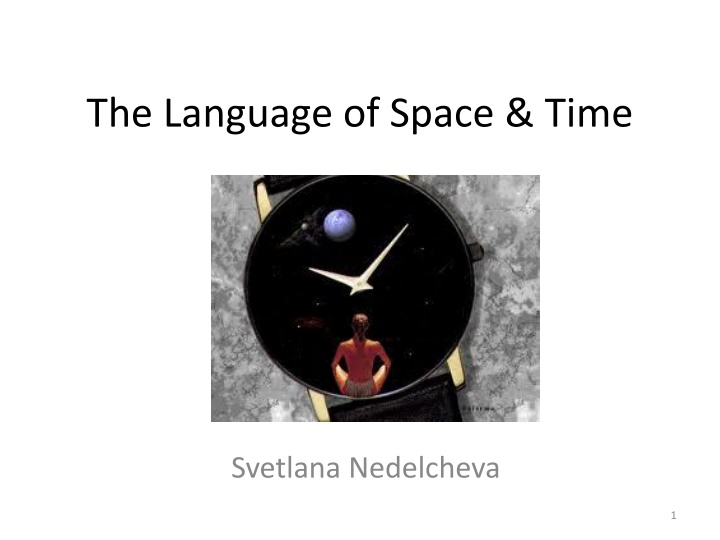

![Read⚡ebook✔[PDF] Linking the Space Shuttle and Space Stations: Early Docking Te](/thumb/21519/read-ebook-pdf-linking-the-space-shuttle-and-space-stations-early-docking-te.jpg)
![READ⚡[PDF]✔ Emerging Space Powers: The New Space Programs of Asia, the Middle Ea](/thumb/21554/read-pdf-emerging-space-powers-the-new-space-programs-of-asia-the-middle-ea.jpg)



